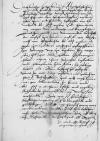Dem durchlauchten, hochgebornen furstenn und herrn, herrn ⌊Albrechten⌋, marggraff zu ⌊Brandenburgk⌋ etc. und hertzog in [⌊Prewssen⌋], etc. unserm hoch... genedigen hern und freundt
Durchlauchterr, hochgebornerr furst, hochgelybtherr herrr und freundt / und genedyger her. Unser freuntliche, wyllige dinst zuvoran. /
Uns sein dyse thage / von dem hochwirdigsten, / unsermm lyben hernn und freundt / ⌊byschoffen von Ermelandt⌋ ⌊koniglicher maiestet⌋, unsers allergnedigsten hernn, brive von wegen des contractss mit ⌊konniglicherr erweltherr wirdt / von Dennemarcken⌋ botschafftter / vorfast zcw komenn. / Und so wir dyssmalh von hochgedachter ⌊koniglicher maiestet⌋, unserm allergnedigsten hern, / zw andren wichtigen geschefftenn gen ⌊Dantzig⌋ uns zw begeben ihm wege / sein, / hab wir dem edlen, gestrengenn hernn ⌊Achacio Cheme⌋, dantzker castellann und hawptman zum ⌊Stume⌋, / dy selbige bryve mit allem befhelh zw geschickt, / domit her mit dem erstennn / mit gedachten hern botschaffterr / zceit und mass benueme, / gen ⌊Marienburg⌋ zu komenn und konigliche maiestet, unseren allergnedigsten hernn, / befelhe und wyllenn nachstellende zcum ende, / wy vorlassen, vorhandle, / das wir so freuntlicherr, dinstlicherr meÿnung Ewer Furstliche Gnaden, der gesunde und gluckselige ankunfft / wÿ hertzlich gerne vornomenn und uns der selben gunst thun befelhenn, nicht haben wol[lt] vorhalthen. /
Datum uff koniglichem schlose ⌊Meue⌋, den XVII April M D XXXVten.
⌊Ioannes⌋, colmischer bischoff subscripsit
⌊Georg von Basen⌋ etc. eigenhant

